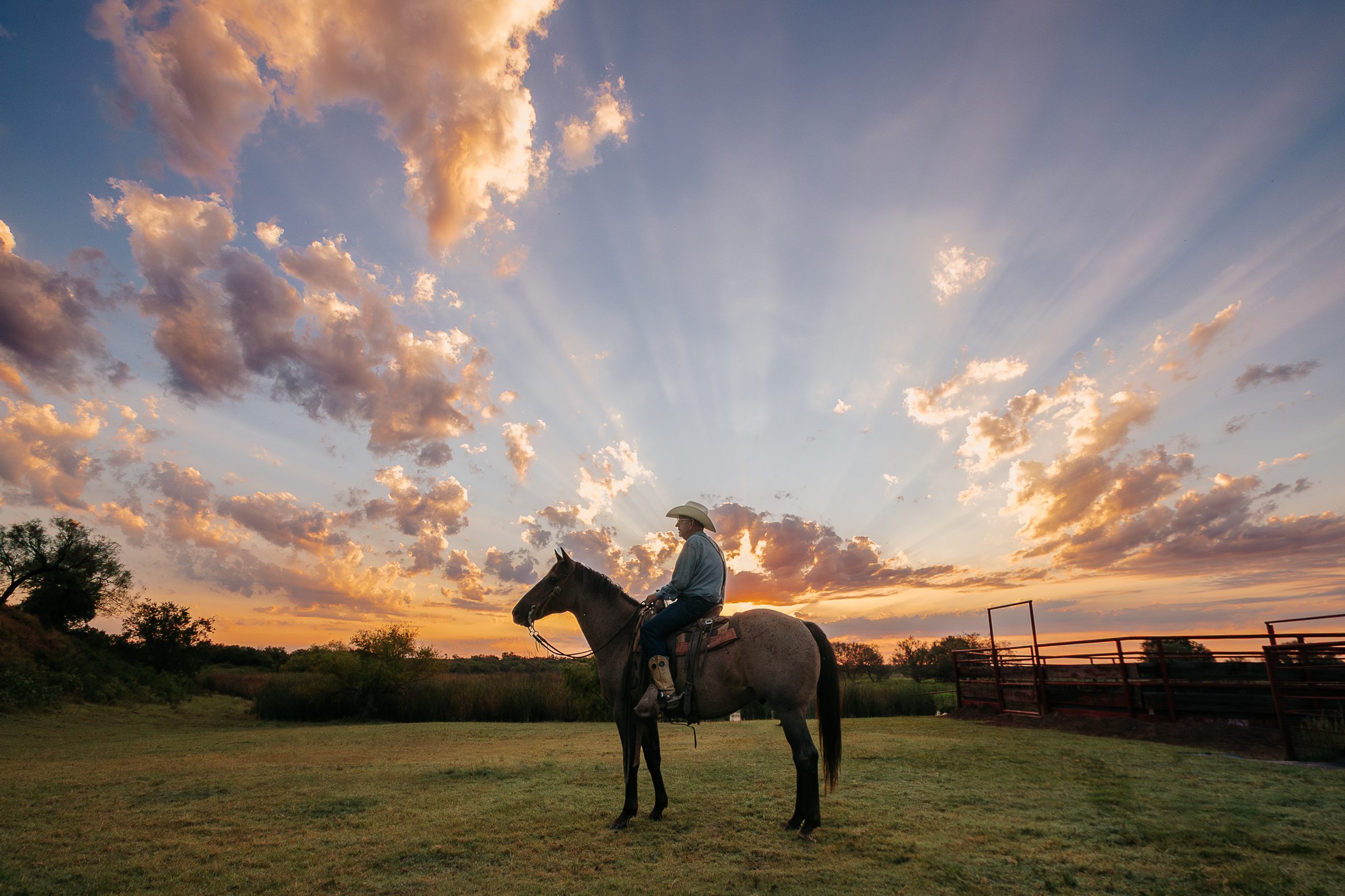Article appears in Summer 2025 Ranch Record; written by Bob Welch
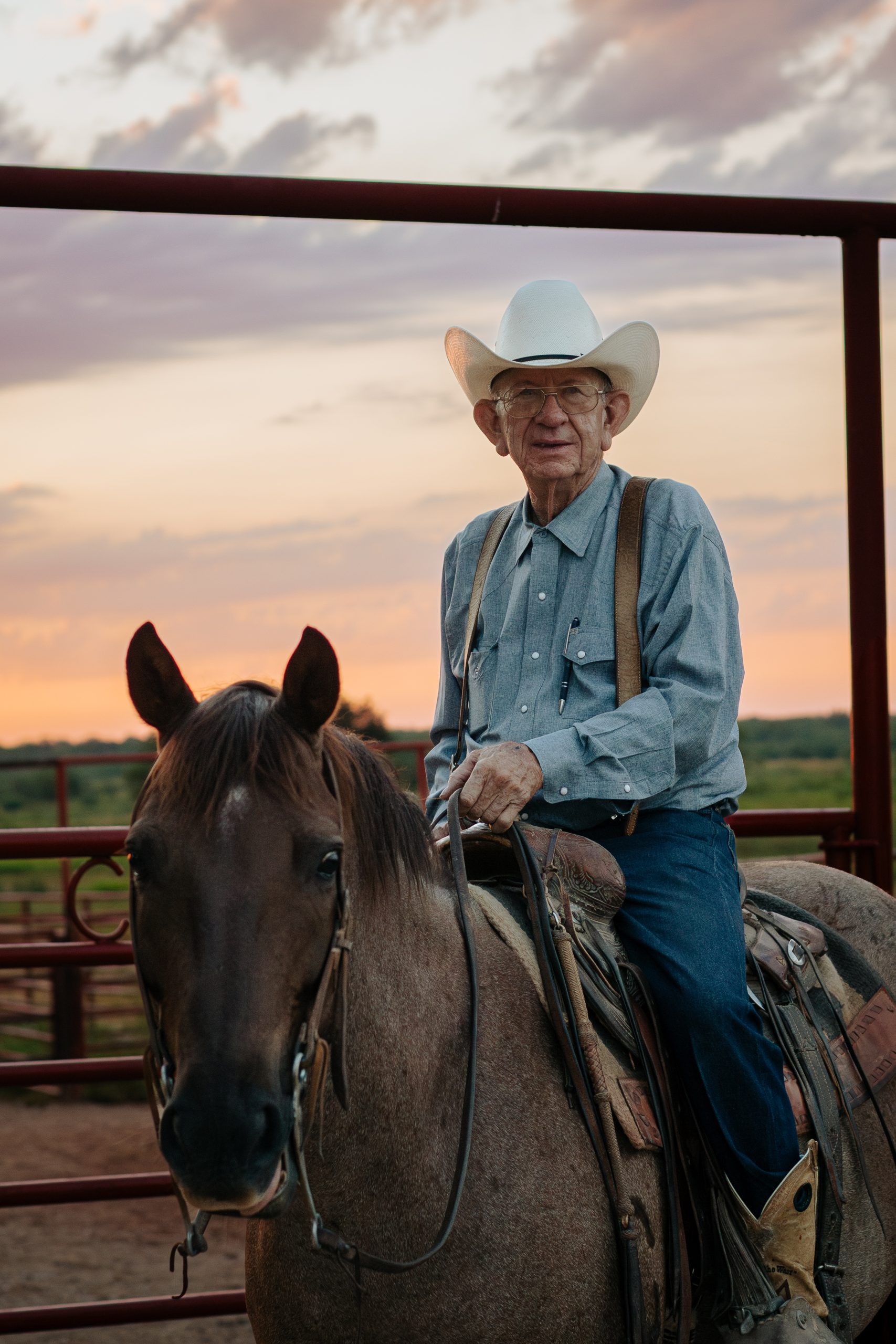
Tom Moorhouse still sits high in the saddle at daybreak. Photo by Adrian Hawkins, NRHC Communication Manager.
Tom Moorhouse just might be the quintessential Big Ranch Country cowboy. His booming voice drips with Texas cowboy drawl as he spins yarns about the first “raynch” his grandaddy bought not having “feences” or water and how as a family they’d attend church at the First Christian Church of Benjamin, Texas, every “Sundee.”
His eyes are closed by the sun and his skin wrinkled and tanned from a lifetime spent out-of-doors. His height is accentuated by an ever-present hat (unless he’s inside) and high-heeled custom-made boots with his britches tucked in. He moves with a purpose, but somehow looks slightly out of place afoot. Though he can’t ride as much or as fast as he once could, his natural habitat is atop a horse.
As one of the 2025 recipients of the Ranching Heritage Association’s Working Cowboy Awards, there is no doubt Tom Moorhouse is as cowboy as they come.
Born the third of four boys on his family’s ranch in King County, life for Tom Moorhouse centers around his family, cattle, horses and his Christian faith.
“Daddy taught all of us boys about cowboying,” Tom says of his father, Togo. “He wasn’t just terribly patient, but he did pretty good for a fellow of his age. Little gruff, but we were used to it.”
Togo came by the gruff naturally. His father came to King County in 1905 after running cattle on the Indian Territory in the 1880s and put a ranch together only to lose it in the droughts of 1918. Determined to buy the ranch back someday, Togo pushed hard. He worked for a dollar a day and raised his family in a hardscrabble country with no inheritance and no oil. Eventually that grit paid off and he was able to buy the ranch back, demonstrating to his four young sons the rewards of determination.
Togo raised Yellow Wolf horses, which were known to make good ranch horses if you stayed with them until they were done bucking. Some stayed with their bucking longer than others.
“We’d run the broncs in the round pen and fore foot them and put a hackamore on them and tie one foot up while they were down,” Tom says. “And then they’d get up, and we’d saddle them, get on and then we’d take the foot rope off and, of course, they’d buck around a good bit.”
In Togo’s round pen, the gate had a distinctive squeak when it was being opened or closed. Worried the horses wouldn’t learn to travel out if they stayed in that round pen too long, Togo would often open the gate with those boys on t heir horses for only the first or second time–regardless if the particular boy ahorseback thought it was time to leave the bronc pen or not.
“When I’d hear that gate squeak, I thought, ‘Oh, we’re fixin’ to go for a ride. And we did,'” Tom says. “I don’t think that should still be the way we do it because we built a lot of resistance in those horses that we had to take out of them for years. And the way you do it now, you don’t build a resistance in them. And you make the horse think he’s doing it right.”
When Tom graduated high school, cowboyin’ was the only thing on his ind and he didn’t have to go far to find it. George Humphreys was hiring at the Four Sixes and Tom signed right on.
“The cattle were wild and the brush was thick.” he says. “The horses pitched and everybody smoked Bull Durham cigarettes and drank Old Crow whiskey. I really thought that was just what I wanted.”
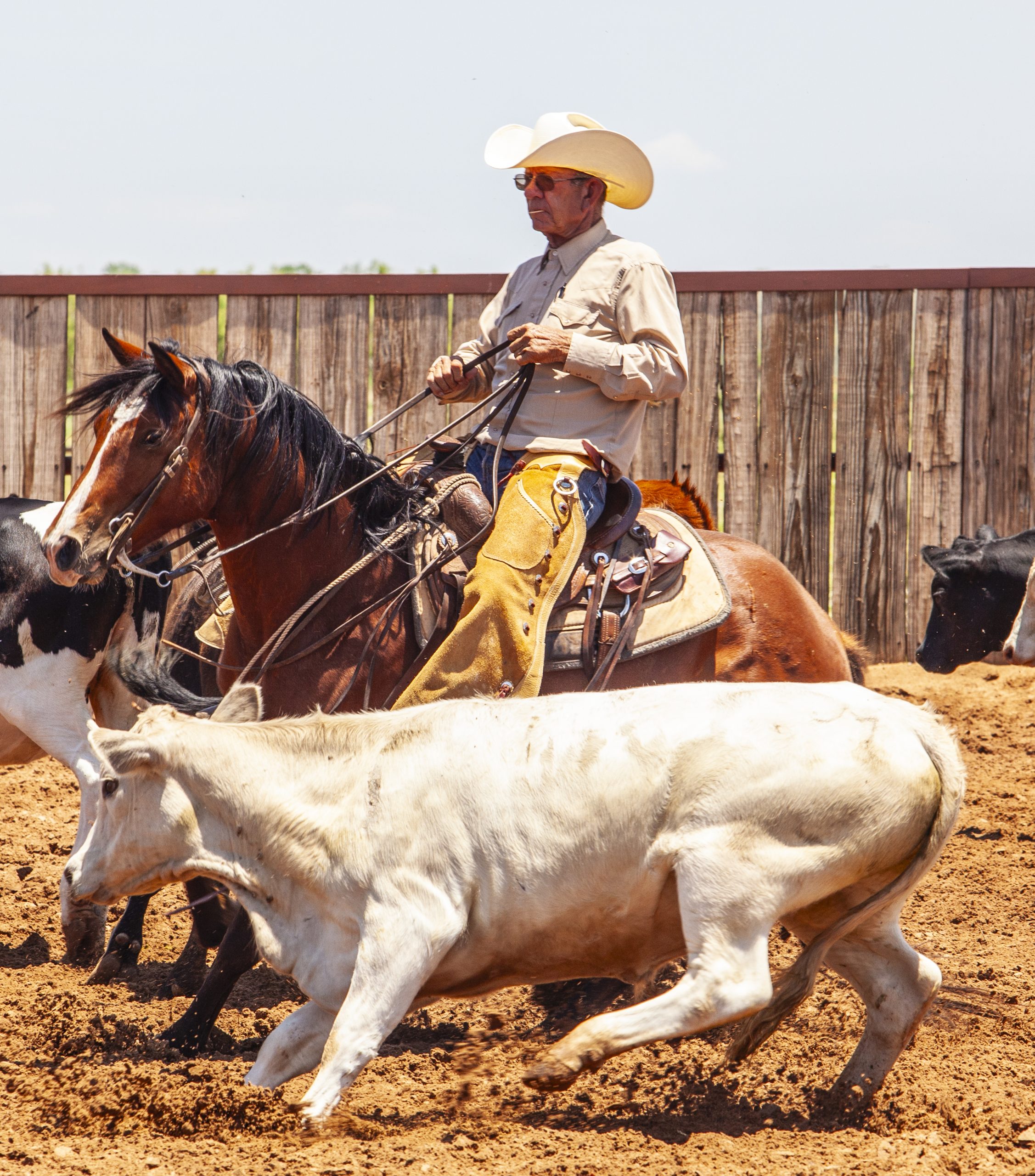
“I never have got over the way I was raised.” – Tom Moorhouse. Photo by Peter Robbins.
It wasn’t exactly what. his parents wanted for him, though, and eventually Togo and Lucille convinced him to attend Sul Ross University in Alpine, Texas. Tom, however, was not an ideal student.
“I didn’t come back with the education, but come back with an outstanding wife,” Tom says. “She was the kind that could doctor a sick yearling or teach Sunday school A real good companion.”
Tom and Sue moved back to the ranch in Benjamin and Togo and Lucille moved into town. They were raising two children when, in 1987, Sue passed away from cancer. Two years later, Tom remarried Becky Elliott, who had been raised on the Waggoner Ranch and had two children of her own. Later, Tom and Becky welcomed son, Gage, to the family. They raised the family and worked the ranch together. After her own battle with cancer, Becky passed away in 2012.
“A lot of people don’t get one good wife,” Tom says. “I’ve had two, so I don’t have much to bellyache about.”
Bellyachin’ was never part of the deal. When Tom and Sue first moved back to the ranch and leased it from the family, he and his older brother John partnered on the cattle and leased as much country beyond the original ranch’s borders as they could. It was always rough country that called on tough men and good horses.
“We had lease ranches scattered all over the country,” Tom says. “We used a wagon because we’d go to the lease ranch and camp there for a few days and it was practical for us to do that.”
The Moorhouse Ranch has always roped and thrown their stud colts to cut and brand them, never hauled horses when they could trop and slept outside during the works. His camps at the wagon were known for warm water and hot coffee–no ice in the drinks. Up before daylight and working until dusk.
“I’ve been so cold I couldn’t button my britches up, so hot that the sheets were wet in my bedroll and so wet that it filled my boots up and my danged old slicker was at the wagon again,” he says. “I’ve been exposed to all that. That’s all I ever really knew and all I ever thought about.”
Tom’s reputation is one of a man willing to stick to the traditional methods of the cowboy profession until they proved inefficient. He’s also carried the reputation of a bit of a skinflint. He’ll say when he hires day help that he only expects a man to work for a half day, he’s free to do what he wants with the other 12 hours. One of the more famous stories about Tom’s frugality was in his tradition of purchasing groceries for his cowboys so they never needed to go to town. One young puncher asked for ketchup. Tom brought him back vinegar and tomatoes.
“Trying to keep up with Tom was difficult,” says his longtime friend Peter Robbins. “He went hard through rough country at a high rate of speed to get to cattle. Tom’s no dummy, he is a smart man, if there was a better way in the kind of country he runs cattle in, he might do it. But in West Texas you have to have a good horse. And you can’t just have any horse, you have to have a horse that’s cowy. Those traditions make sense.”
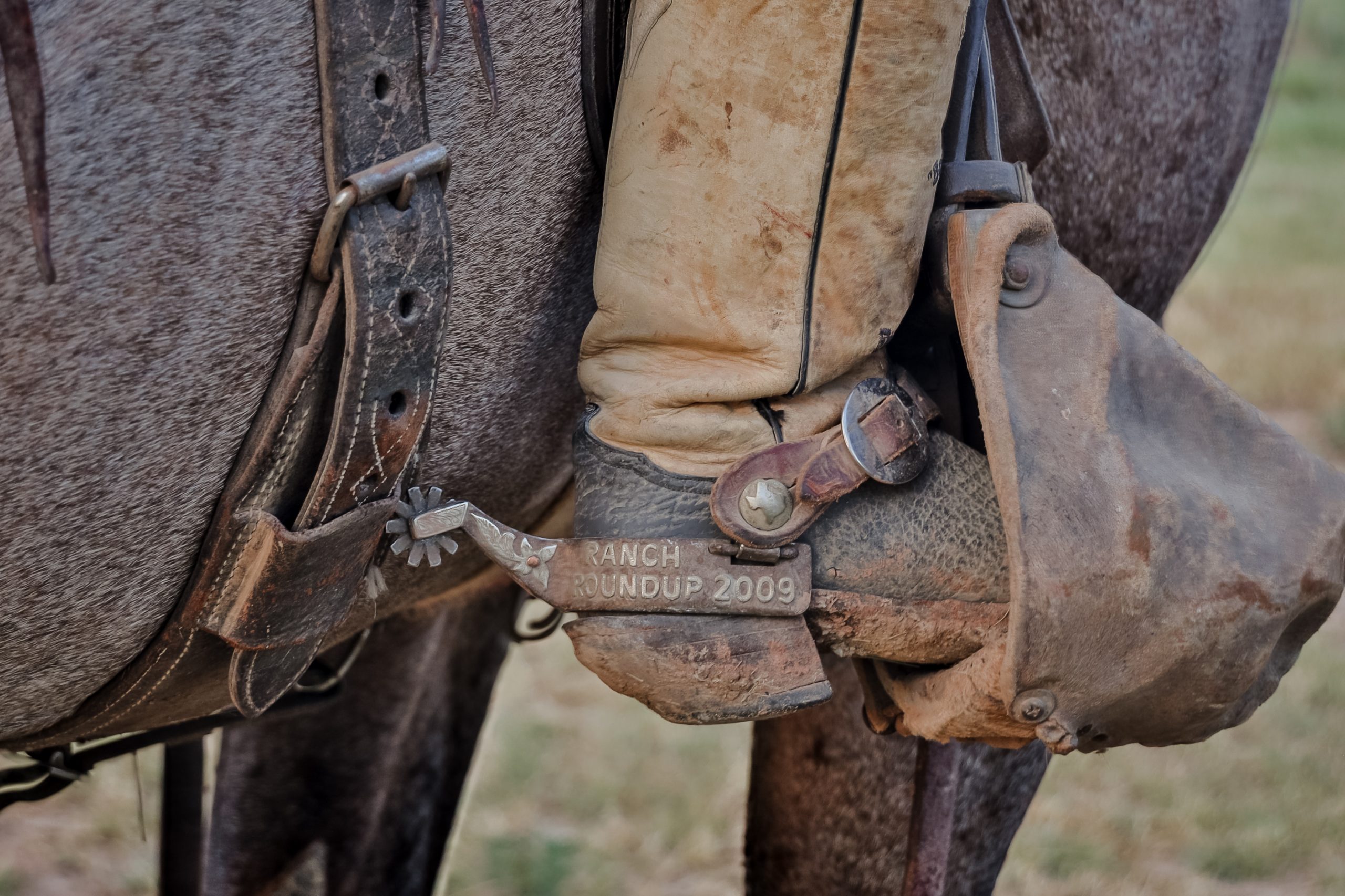
Tom Moorhouse sporting the 2009 Ranch Roundup spurs. Photo by Adrian Hawkins.
The steadfast commitment to his craft has manifested itself in a variety of ways over the years. At the first ranch rodeo ever produced, the Texas Ranch Roundup in Wichita Falls, Tom won Top Hand. The next year, his team won the rodeo–and repeated in subsequent years. He was a founding member of the Ranch Horse Association of America and honored as the youngest cowman to ever receive the Foy Proctor Award. In 2005, he was inducted into the Texas Cowboy Hall of Fame. in 2008, Moorhouse Ranch received the American Quarter Horse Association’s Best Remuda Award. In 2011, after Tom became manager of the Tongue River Ranch, they won the same award as well.
Tom, his brother John and another partner, Millard Morris, were leasing the Tongue River Ranch in the 1990s when it came up for sale and Morris bought it. Within a few years, Morris convinced Tom to run the ranch for him. It wasn’t what Tom was looking for, but i the end, it did make sense.
“It was a good experience for me,” Tom says. “Working several men and had 70 head of mares and 1,200 cows and three or four employees. I enjoyed it. I kept two men down at the ranch I owned. Millard and I got along real well together. Nearly all of the men that I worked there were good guys, real good guys, good hands, and that mattered.”
But during his stent at Tongue River, challenges came his way. The first was an extreme drought: by some measures the worst that country had seen since it was settled. Ranches all over Texas were selling cows or shipping them to northern ranges. Tom was working to get the Tongue River cattle to Montana. Meanwhile, Becky was dying of cancer.
“We were all there and buried her casket,” Robbins remembers. “All the guys on the crew at Tongue River and his sons. He said to everybody, ‘Guys, the only way I can deal with this is to go hard. If you’re willing, we’re going to see some country and go harder than we’ve ever gone and harder than you may ever go again.’ We camped the whole way to Montana and back and Tom never stayed in a tipi. He just wanted to be under the breath of heaven while he was grieving Becky. It was just a powerful thing to see. He became a new creature in Christ, and it was profound to see it and was inspiring. I know that I’m not the only one he inspired to good works and a deeper walk with God.”
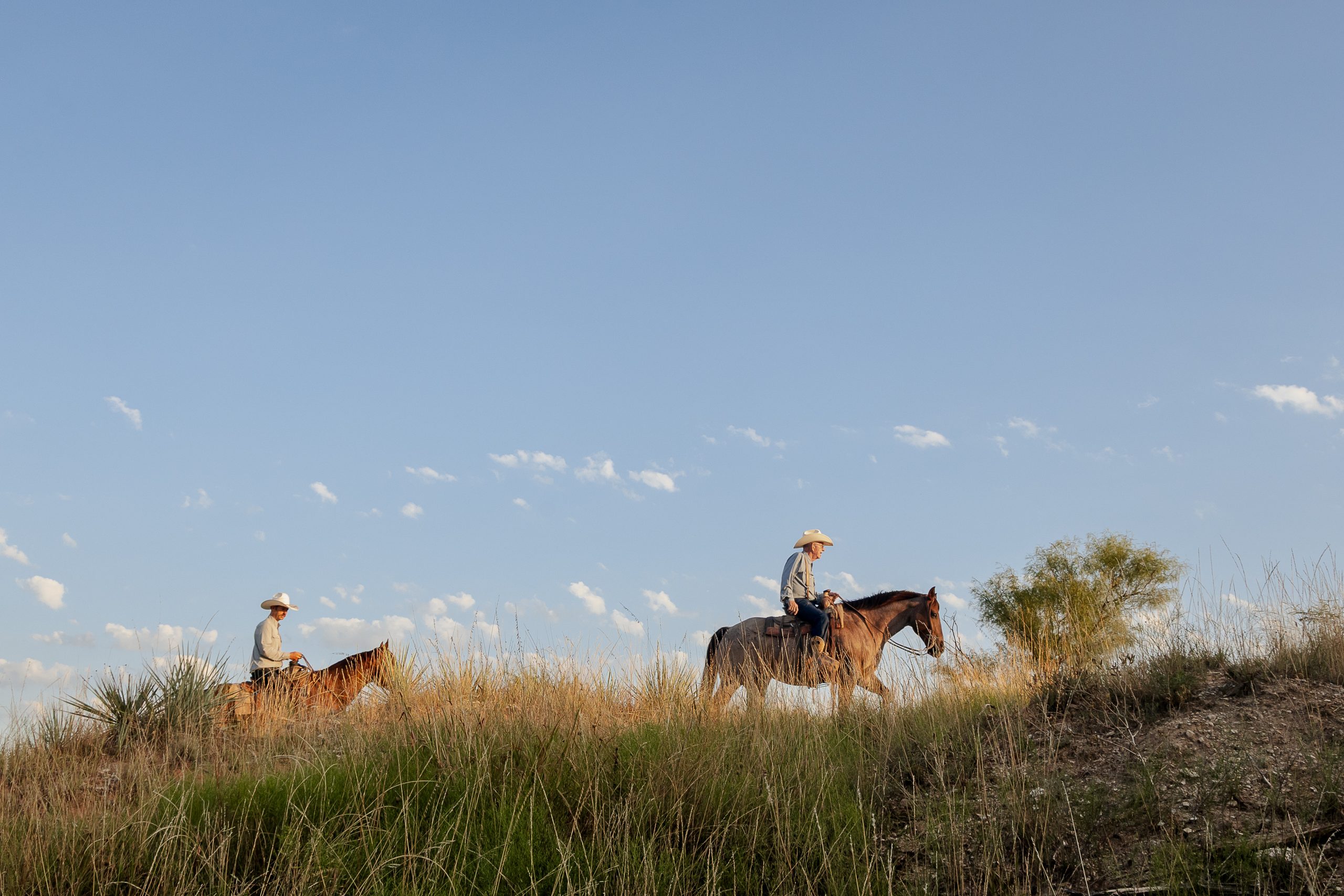
Tom riding with his son, Gage, on the Moorhouse Ranch. Photo by Adrian Hawkins.
He stayed with Tongue River until the drought was over and then retired back to the ranch at Benjamin. HIs son Gage and his wife, Laura, have since taken over the reins of the Moorhouse Ranch and are expanding the offerings to custom-finished beef.
“I’ve been living by myself for eight or 10 years,” he says. “I don’t particularly like it, but that’s just the way it went. People ask me if I was a cowboy, and I tell them, ‘I don’t know, but I have been exposed to it.’ For all my life it’s everything I ever thought about, all I ever wanted to do, all I ever did.”
To wit, even in retirement Tom cowboys. He helps on the Four Sixes, helps Gage and travels with friends, but his body doesn’t allow him to do things he once did. He muses that now he gets dropped off on the inside circle and gets to go through the line first at the wagon.
“He is known for being a great man who was a great horseman and a great cowboy,” Robbins says. “But as his arms became more and more stiff and his shoulders got worse and worse, everybody marveled at what he could do dragging calves tied on or calmly working a gate. He will always be remembered as a great hand and a man of God.”
Like anyone who has a deep, abiding passion for his life’s work, Tom worries about its future.
“I remember when the ’60s, we worked seven days a week,” he remembers. “And that wasn’t necessary, but the trouble is now, they might take off at noon on Saturday and they might even take Saturday off, which I”m not for that. We hauled hay and fenced and did everything. A cowboy needs to be willing to help do anything, but he is not really content unless he’s sitting on a horse.”
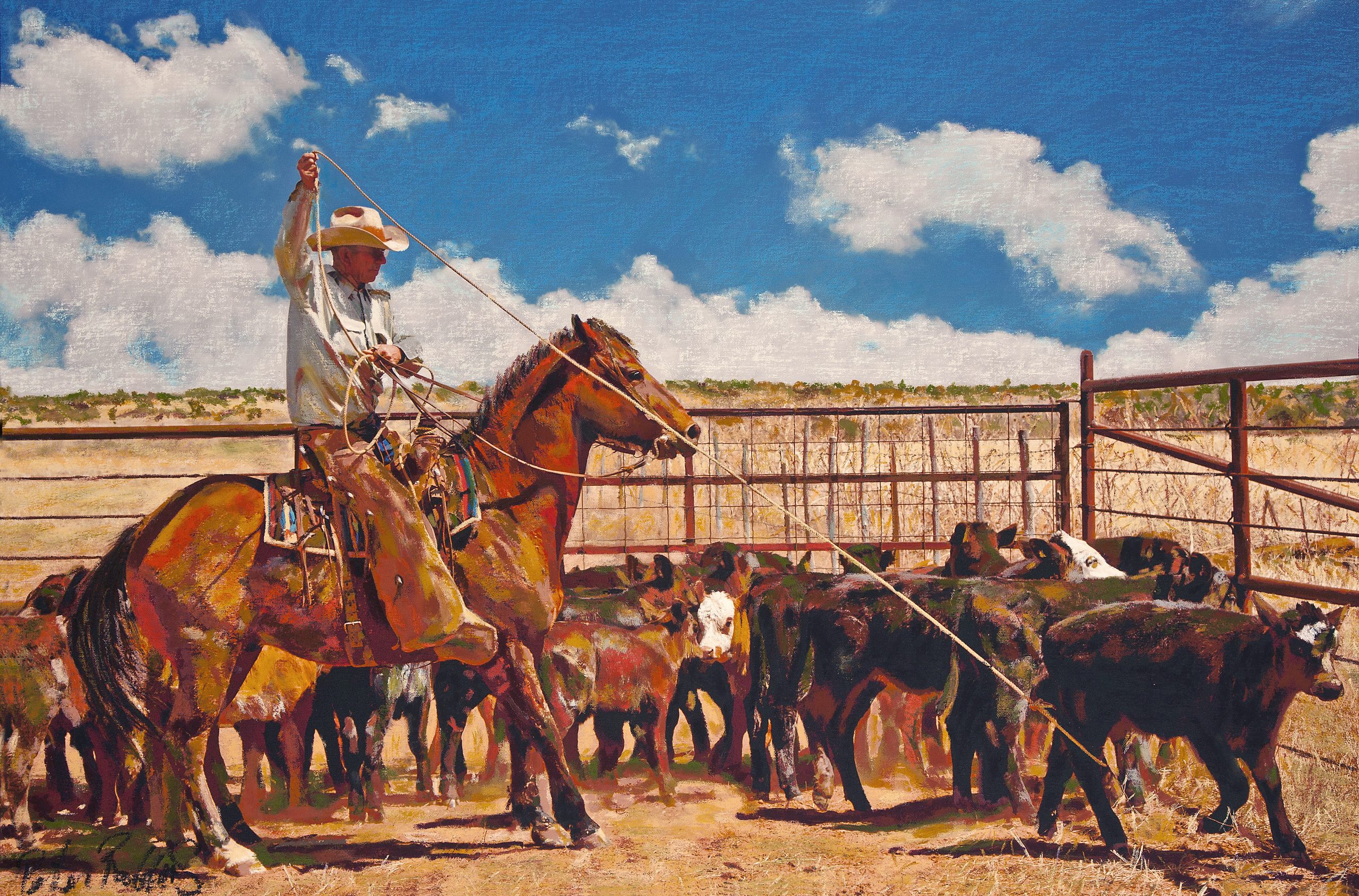
“Tied to Tradition” painting by Peter Robbins of Tom Moorhouse.
Tom’s mind is deceivingly active. Observers might mistakenly believe all he thinks about is horses and cows. But as Father Time and Mother Nature have forced him to slow his pace on the ranch, his thoughts have expanded beyond the mere mechanics of ranching to the meaning of his life’s work.
“I’m going to keep the tradition going,” he says. “We don’t want our children and grandchildren not to realize how we did things and maybe to them, it would sound pretty tough. I’ve read Charlie Goodnight’s book and learned a lot about him. He was a real cowman. I realized how much that means to me, and maybe what we do today, interviewing and talking about it, will mean a lot to our grandkids or great grandkids. So that’s why I like to keep it going. I think there’s something to having an appreciation for your forefathers, you know, whether it’s actual blood or not. If. you can understand what they went through, it almost makes you want to step up and do your part.”
Like Charlie Goodnight, Tom Moorhouse is a legend in ranching. And while he never hesitates to extoll the virtues and details of his way of life to keep the traditions alive, he does much more than that. He sees an even higher calling than the preservation of his culture and cowboy method.
“Probably the greatest thing my parents did is they took us boys to church every Sunday,” Tom says. “We learned about Jesus Christ and that, that’s the most important thing we’ve ever done.”
Though Tom himself strayed from his faith for a time, his cowboy credibility gives him the unique opportunity to speak into the lives of many young cowboys who think–like he did–that being a cowboy means riding horses that buck, roping wild cows, smoking Bull Durham cigarettes, dirnking Old Crow whiskey and chasing women.
“When he came to visit out of the blue the other day, we talked a lot about God.” Robbins says. “He tells young men who are struggling with alcohol or infidelity what it really takes to be a man. You’ve got to rise to the occasion and you can’t do it as a drunk or a goof-off. He’s touched a lot of men’s lives in his own way. His greatest legacy is as a man of God.”
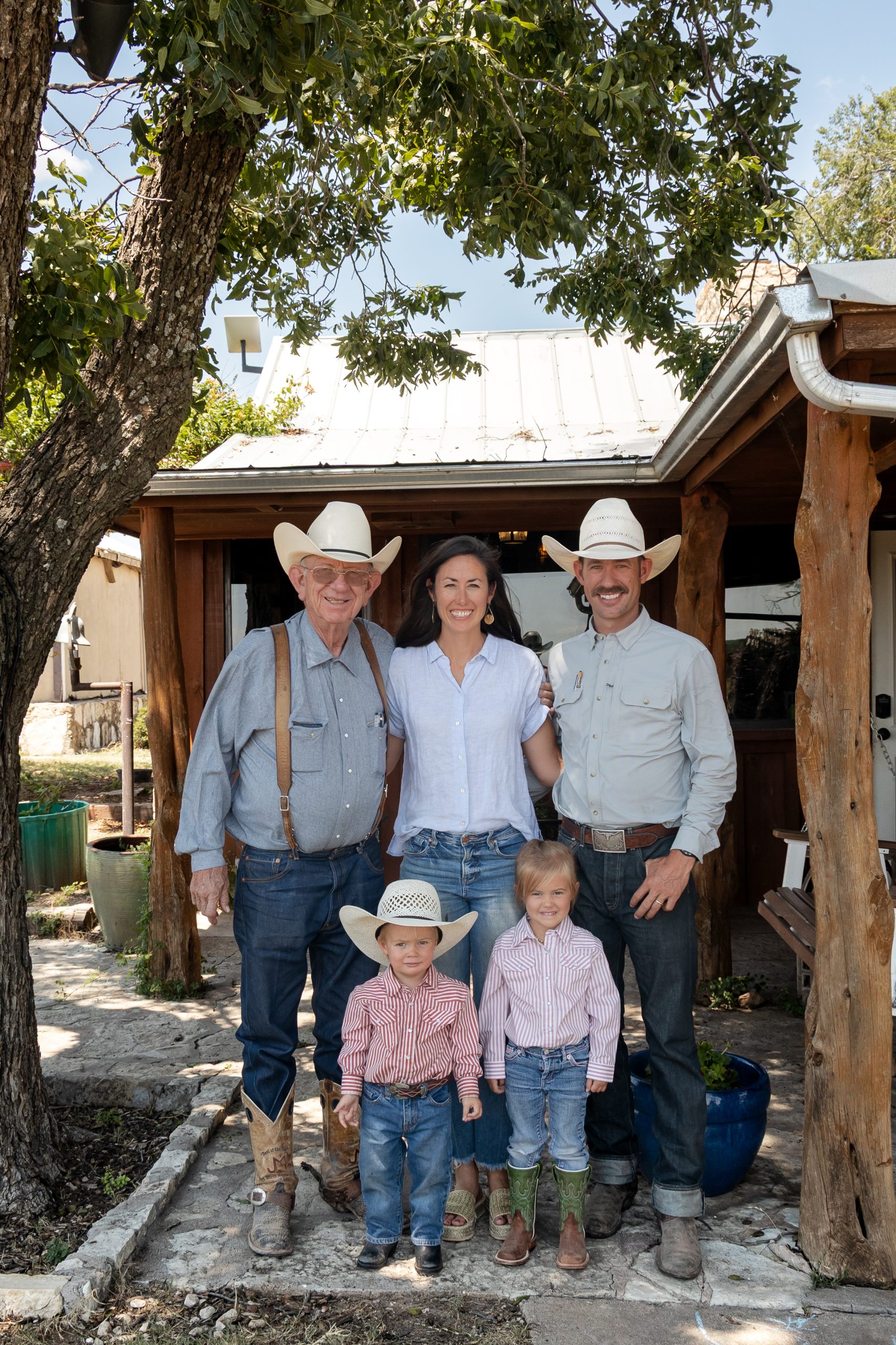
Tom Moorhouse with his daughter-in-law and son, Laura and Gage, and two grandchildren. Photo by Adrian Hawkins.
Thank you to Livestock Nutrition Center for being the 2025 sponsor for the RHA Working Cowboy Award-East.


